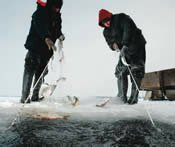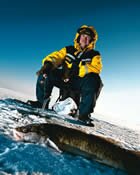Inflight Magazine of Brussels Airlines
Welcome to the Inflight Magazine of Brussels Airlines
Gone fishin’
Lithuania boasts around 6,000 lakes, which come alive during the ice-fishing season (January to March). With rod in hand, Nathan Greenhalgh finds peace, quiet and pike
 This January afternoon the frozen lake is totally deserted, apart from Tadas Guobuzas, my fishing mate, and me. We are wrapped up in our Carhartt float coats, scarves, gloves, woolly hats, boots and blankets, sitting round the water hole, clutching our rods.
This January afternoon the frozen lake is totally deserted, apart from Tadas Guobuzas, my fishing mate, and me. We are wrapped up in our Carhartt float coats, scarves, gloves, woolly hats, boots and blankets, sitting round the water hole, clutching our rods.
I look across the ice. The sky is white and grey and blends into the ground. The lake, which is called Kertuojai, is about 2.4km2 and surrounded by snow-covered evergreens and small hills. It’s beautiful and untouched, and it feels like being in the middle of Alaska. But this is Lithuania.
Most trips to Lithuania revolve around the capital city, Vilnius. Full of baroque churches, medieval atmosphere and a vibrant nightlife, just staying in the capital is vacation enough for many people. Prices are never more reasonable than at this time of year. Plush four-star hotels in the middle of the UNESCO-heritage-site Old Town are going for only €60 a night during the winter, and discounts are typically given for booking several nights in a row.
But staying only in town, you’ll miss out on the peacefulness of the lakes, the thrill of reeling in a big pike, and a keen understanding of Lithuanian culture.
 Fishermen appear in several Lithuanian myths. In one, a distraught goddess weeps tears of amber that wash up on the shores of the Baltic Sea. She’s grieving for her lost love, a mortal fisherman.
Fishermen appear in several Lithuanian myths. In one, a distraught goddess weeps tears of amber that wash up on the shores of the Baltic Sea. She’s grieving for her lost love, a mortal fisherman.
Lithuanians are uniformly nature lovers, and when you get out into the countryside, you’ll see why. The rolling hills and thick forests are dotted with around 6,000 lakes, meaning there’s practically one around every corner. Go to the right lake and you won’t have to worry about returning empty-handed. Even though your typical Lithuanian has been fishing every weekend since learning how to walk, there are so many lakes that you’ll rarely find a crowded one. It’s excellent territory for fishing tourists – unspoiled nature, solitude, and plenty of fish to catch.
Once you know where to go, you can net about 10 fish, typically pike, bass and bream, in one afternoon. Being the least bony, pike are best for eating, and locals love to fry them up fresh, head and all. Pike goes great with a golden Lithuanian lager, potato pancakes and sour cream.
 If it’s big enough, the fish ends up mounted on the wall – most rural Lithuanian homes are adorned with a relative’s big catch.
If it’s big enough, the fish ends up mounted on the wall – most rural Lithuanian homes are adorned with a relative’s big catch.
Fishing is ingrained in the local economy, and finding shops for gear is no problem. There are 24-hour bait shops in nearly every small town and, while the staff often speak limited English, they are generally very helpful. A year-long fishing licence, which costs a mere 15 litai (€4), must be bought before hitting the ice with a bucket of minnows and maggots – and a drill.
Given the multitude of lakes, the best choice depends on what the fisherman is looking for. The most tourist-friendly option is Lake Galve, just 28 km from Vilnius. The lake features the stately, resplendent Trakai Island Castle, that looks as if it has stepped straight out of an Arthurian legend. The small town of Trakai hugs the lake-front and offers numerous restaurants, bars and hotels. However, Trakai is one of Lithuania’s main tourist attractions, so you won’t get as much peace and quiet there as you will a bit further afield. You also won’t catch as many fish.
 For a truly post-Soviet experience, there’s the Ilgis Lake, near Elektrenai. It’s not exactly picturesque, as it’s next to a grey, decaying power plant. But purely for fish-catching points, it’s hard to beat.
For a truly post-Soviet experience, there’s the Ilgis Lake, near Elektrenai. It’s not exactly picturesque, as it’s next to a grey, decaying power plant. But purely for fish-catching points, it’s hard to beat.
“We’ve tried a lot of lakes but we’ve always caught the most pike here,” Tadas told me. And he’s been to over 50 lakes in Lithuania. I suppose the decision whether to choose this lake or not depends on how hungry you are.
My favourite lakes lie in Lithuania’s north-east hinterland. Near Moletai is Lake Kertuojai, part of a chain of lakes that extends into the Aukstaitija National Park. Here, the hills become a bit higher, the forests thicker, the lakes more beautiful and secluded. With the help of a map or a friendly local, several different lakes can be tried, until you find the one you like best. There are plenty of rental cabins to be had if you want to spend a couple of days in the sticks before returning to Vilnius.
Out in the cold, with a little beer or warming vodka, waiting for a green and yellow-spotted wriggler to bite and breathing the crisp, clean air, feels both revitalising and soothing.
Taking a friend is important, as ice fishing is not without its dangers. It’s best to go only during the day, in case the ice does give way. Wearing a float coat is a good precaution, and be sure to test the ice a bit to see if it’s thick enough. Falling in is, needless to say, not advisable.
Practicalities
What you need to know
Getting around
To reach any of the rural lakes around Trakai, renting a car is a must. This is easily done in Vilnius and starts at 100 litai (€30) a day. Just as in the West, petrol stations are everywhere; the price of a litre is 3.70 litai (€1,07) for petrol and 3.10 litai (€0,90) for diesel. Having a coffee before driving is recommended, as Lithuanian driving habits demand alertness – especially on the single-lane highways!
When to go
The dates of the ice-fishing season vary each year, based on the coldness of the winter, but it generally runs from the first week of January to the second week of March. While these are the most perilous times for falling in, the first and last lake freezes are when fish bite most. Make sure the ice is at least 10cm (4in) thick.
What to take
The Romada fishing equipment stores are not expensive and are easy to find. A drill, a fishing rod, hooks, minnows and larvae (not worms) for bait, a mandatory fishing licence and a life preserver or float coat can all be sourced there. A bucket to store the fish, warm clothing, a spare set of dry clothes in the car, and a cell phone, in case of emergency, should all be packed too. Cellular reception is good throughout Lithuania.
Vocabulary
■Fish — zuvis
■ Fisherman — zvejys
■ Minnows — mailius
■ Larvae— uodo truklio lervos
■ Caterpillar— kirmeles
■ Fishing rod— meskera, meskerykotis
■ Fishing line — valas
■ Bobber — plude
■ Ice drill — graztas
■ Vodka — degtine
■ Beer — alus
■ You smell fishy— Smirdi zuvimi
FR Quelle pêche !
La Lituanie possède près de 6 000 lacs qui s’animent durant la saison de la pêche sur glace (janvier à mars). Canne en main, Nathan Greenhalgh y a trouvé la paix, la quiétude et du brochet
Le ciel, d’un blanc gris, se confond avec l’horizon. Le lac, appelé Kertuojai, d’une superficie de 2,4km est entouré de petites collines toujours verdoyantes, aux sommets enneigés. Le paysage est splendide, préservé et on a l’impression de se trouver en plein Alaska. Mais c’est la Lituanie.
Bien que le Lituanien typique pêche tous les week-ends depuis qu’il a appris à marcher, le pays possède tellement de lacs qu’il est rare d’y croiser beaucoup de monde à la fois. Ce territoire est fantastique pour la pêche touristique – une nature intacte, la solitude garantie et une foison de poissons à attraper. Et si vous savez où aller, vous pourrez prendre environ 10 poissons - de type brochet, perche et dorade - en une après-midi.
Au vu de la multitude des lacs, le meilleur choix dépendra de ce que le pêcheur recherche. Le lac de Galve, à seulement 28 km de Vilnius, est l’option la plus agréable pour le touriste. Envie d’une vraie expérience post-soviétique ? Allez au lac Ilgis près d’Elektrenai. Ce n’est pas ce que l’on pourrait qualifier de pittoresque, l’endroit jouxtant une centrale électrique grise et délabrée. Mais du pur point de vue de la pêche, c’est incomparable.
Mes lacs préférés sont localisés dans le territoire du nord-est de la Lituanie. Près de Moletai se trouve le lac Kertuoja, qui fait partie de la chaîne de lacs qui parsèment le Parc National d’Aukstaitija. Ici, les collines prennent de la hauteur, la forêt de la densité et les lacs deviennent plus beaux et retirés.
Il est important d’emmener un ami avec soi, car la pêche sur glace n’est pas sans dangers. Il vaut mieux s’y rendre durant la journée au cas où la glace cèderait. Porter une veste de sécurité avec flotteurs est une précaution d’usage, et assurez-vous de tester l’épaisseur de la glace avant de vous aventurer. Cela va sans dire, tomber n’est pas recommandable !
NL Ben gaan vissen
Litouwen heeft ongeveer 6.000 meren, die tot leven komen in het seizoen voor het ijsvissen (van januari tot maart). Met de hengel in de hand gaat Nathan Greenhalgh op zoek naar rust, vrede en snoek
De lucht kleurt wit en grijs en gaat over in het landschap. Het meer, Kertuojai genaamd, strekt zich uit over ongeveer 2,4 km en is omgeven door met sneeuw bedekte dennentakken en kleine heuvels. Het is er prachtig en ongerept, en je lijkt wel in Alaska. Maar dit is Litouwen.
Zelfs al vist de gemiddelde Litouwer elk weekend sinds hij heeft leren lopen, toch zijn er zoveel meren dat je er niet één vindt dat overbevolkt is. Het is een uitstekende plek voor vistoeristen – ongerepte natuur, eenzaamheid en een overvloed aan vis. En als je weet waar je moet zijn, kan je op één namiddag wel een vis of 10 vangen: snoek, baars en brasem.
Met zoveel meren hangt de beste keuze af van waar de visser naar op zoek is. De meest toeristvriendelijke optie is het Galvemeer, slechts 28 km van Vilnius. Voor een echte post-Sovjetervaring is er het Ilgismeer in de buurt van Elektrenai. Het is niet bepaald pittoresk, met zijn ligging naast een grijze, bouwvallige krachtcentrale.
Mijn favoriete meren liggen in het noordoostelijke hinterland van Litouwen. In de buurt van Moletai ligt het Kertuojaimeer, dat onderdeel is van een keten van meren die uitlopen in het nationale park Aukstaitija. Hier worden de heuvels hoger, de bossen dichter en de meren mooier en verder afgelegen.
Een vriend meenemen is belangrijk, gezien ijsvissen niet altijd zonder gevaar is. Je gaat best enkel overdag, in geval het ijs zou beginnen drijven. Een drijfjas dragen is een goede voorzorgsmaatregel en vergeet het ijs niet te testen om te zien of het wel dik genoeg is. Vanzelfsprekend is in het water vallen geen aanrader.
Leave a Reply
